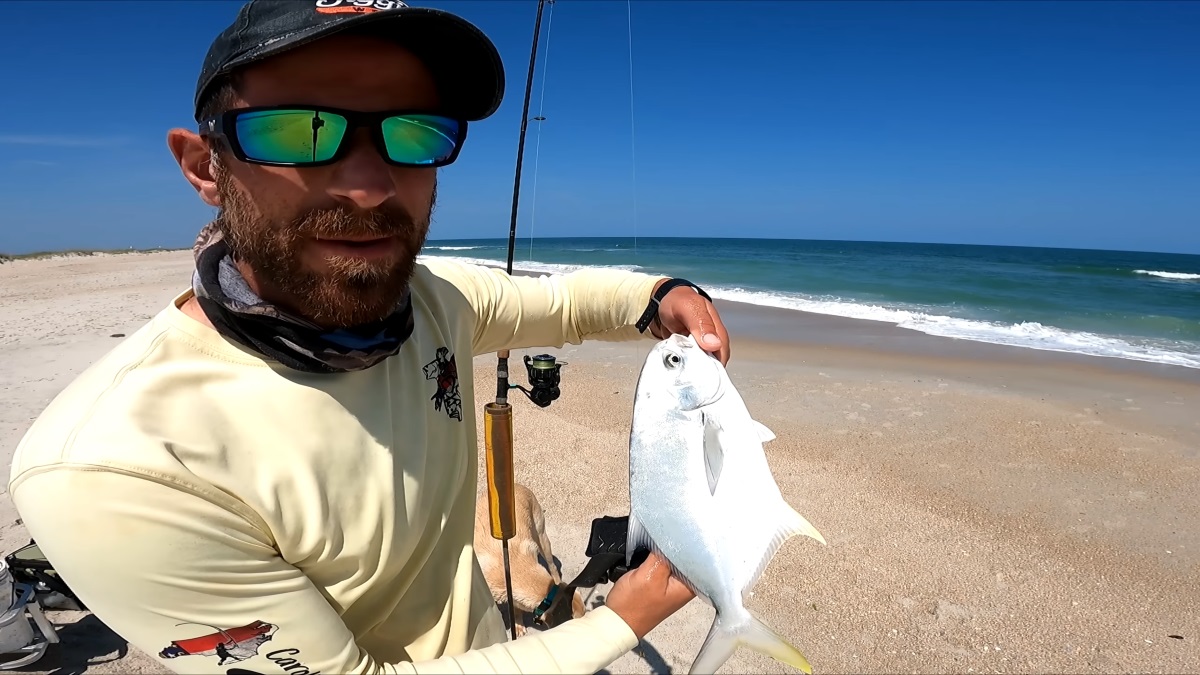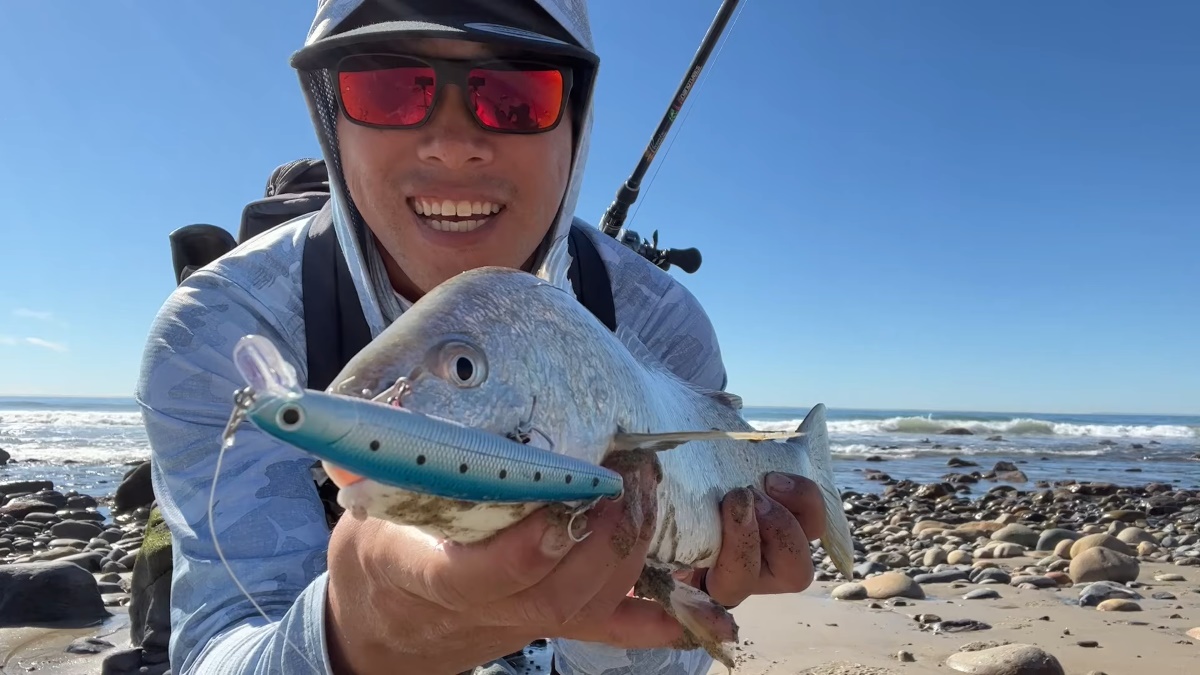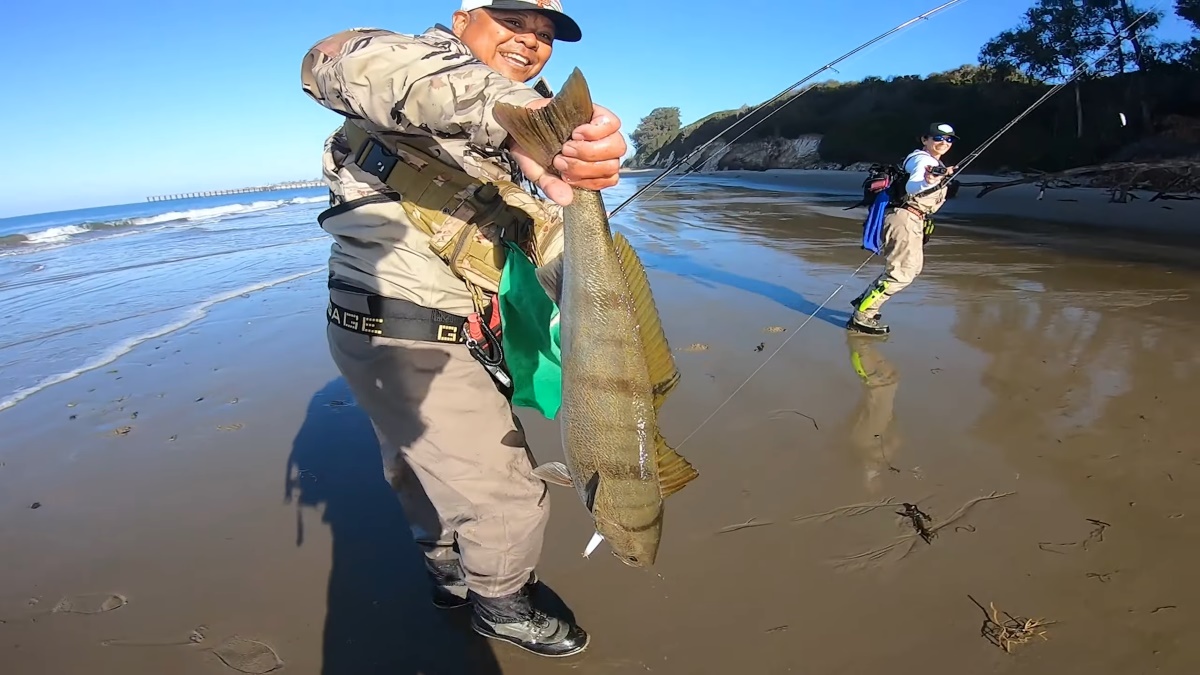If you’re looking for an exciting way to spend the day fishing, surf fishing halibut might be just what you need! Halibut, esteemed among saltwater anglers, offer an excellent chance to broaden your fishing horizons. Explore the depths with these coveted fish and expand your angling prowess.

Surf fishing also presents a challenge as it requires you to set up in more remote and wild areas along beaches and coastal rocks. With patience, skill, and some luck, halibut catches can be plentiful if you know where to look!
In this blog post, we’ll cover getting started with surf fishing for halibut. We’ll discuss likely locations, techniques used by anglers worldwide, and provide gear suggestions.. Read on if you want to outperform everyone else in catching these monstrous bottom feeders!
What Is Surf Fishing for halibut?

Surf fishing halibut is a great way to enjoy the ocean. While it may pose a challenge, the feeling of accomplishment that comes with reeling in your first significant catch is truly rewarding. Halibut spend most of their time near the bottom of the ocean, so anglers must use special tackle and techniques to bring them in.
A surf fishing rod with at least 20 pounds of line is recommended, as it will allow you to cast further out into the surf and reach deeper water where halibut tend to inhabit.
Using a two-hook rig with live bait is an effective method for catching halibut, as they are attracted to the scent of their prey. Long casts are crucial when surf fishing for halibut, so ensure you have the appropriate equipment to reach them.
Surf fishing for halibut is enjoyable and rewarding, but it requires patience and skill. Prior to heading out, it is important to be familiar with the local regulations, as there may be restrictions on size or catch limits.
Fishing in the surf also requires special safety precautions, such as wearing a life jacket and being aware of rip currents. With the right knowledge and equipment, surf fishing halibut can be a great way to enjoy the ocean and land some delicious catches!
Some Different Types Of Halibut
When surf fishing, you can catch a variety of halibut species. The Pacific Halibut is the most prominent, reaching lengths of up to 8 feet and weighing up to 500 pounds. Other notable varieties include the Atlantic, Greenland, and Blackfin Halibut.
Each species has unique characteristics and behaviors, requiring thorough research when targeting a specific type. For example, Pacific Halibut thrives in deep ocean waters and feeds on squid and small fish. Atlantic Halibut prefers shallower waters and has a preference for crustaceans like shrimp or crabs.
What Are Some Regulations And Rules For Surf Fishing For Halibut?

When surf fishing for halibut, understanding local regulations and restrictions is crucial for your safety and compliance. These regulations, such as size limits, bag limits, and season lengths, may vary by state or region. Before your trip, familiarize yourself with the rules and strictly adhere to them while angling.
Consult the National Marine Fisheries Service for additional restrictions or closures in your fishing area. Many areas have specific rules to protect certain fish species, so respect these regulations.
Above all, prioritize safety when surf fishing for halibut. Wear a life jacket, be aware of rip currents and hazards. If uncertain, stay onshore and wait for improved conditions. Enjoy surf fishing for halibut responsibly.
A Detailed Guide For Surf Fishing Halibut

Halibut surf fishing can be a fun and rewarding activity, but it requires some knowledge and preparation in order to be successful. Here is a step-by-step guide to help you get started:
- Research the regulations of the area where you will be fishing, including size limits, bag limits, and season lengths.
- Get the right gear: Use a surf fishing rod and reel with at least 20 pounds of line, a two-hook rig with live bait, and long casts to reach deeper waters.
- Find an area with deep water that is likely to hold halibut. This could be close to a pier, jetty, or rocky outcropping.
- When casting, keep your line close to the bottom and use a slow retrieve with occasional pauses in order to attract the halibut.
- Once you have a bite, set the hook slowly and play the fish out until it is exhausted. Halibut can put up a fight, so be prepared for a battle!
- Once the halibut is reeled in, use a net or gaff to bring it onto shore.
With patience and the right techniques, surf fishing for halibut can be a rewarding experience. Following these steps will help ensure that you have a successful trip and land some delicious catches!
May you like: 10 Best Line For Surf Fishing: Mono, Braid or Fluoro?
Where Do You Find And Catch Halibut?
Halibut are commonly found in the deep ocean and near piers, jetties, and rocky outcroppings. They prefer areas that offer ample hiding spots, often seeking out structures for concealment.
This could include rocks, seaweed beds, kelp forests, and sunken wrecks. When looking for halibut, try to find areas where the water is relatively deep and has some sort of structure.
| Fishing Spot | Description | Techniques |
|---|---|---|
| Sand Flats | Halibut tend to hover near the surface and feed on small fish. They seek areas with structure. | Use slow retrieve with occasional pauses. Long casts are crucial. Use appropriate gear. |
| Tidal Flats | Halibut feed on crustaceans like shrimp or crabs. Regulations and safety precautions are important. | Use live bait or two-hook rig. Long casts are crucial. Adhere to regulations and safety. |
| Underwater Structures | Halibut feed around sunken shipwrecks, reefs, and coral beds. Tackle and bait choice is crucial. | Use appropriate tackle and bait. Adhere to regulations. |
| Kelp Bed Areas | Halibut feed around kelp beds near the shore. Proper gear is important. | Use proper tackle and bait. Long casts are crucial. |
| Horizontal Locations | Halibut feed around sand bars, reefs, and points. Proper bait choice is important. | Use the right bait. Proper equipment for long casts is crucial. |
| Shoreline Cobble | Halibut feed on small fish around these areas. Regulations and tackle are important. | Use appropriate tackle and bait. Adhere to regulations. |
No matter which area you choose to fish in, remember to always practice safe angling habits and respect the local regulations. Safety is crucial when surf fishing for halibut. Wear a life jacket and stay vigilant for rip currents and other hazards. With the right preparation and knowledge, you can have an enjoyable experience while catching some delicious halibut!
When Is The Ideal Time To Go Surf Fishing For Halibut?

For optimal halibut surf fishing, the summer and fall seasons, when the water is warmest, are the prime times. During these periods, halibut tend to migrate closer to the shore in search of food, significantly enhancing the likelihood of successful catches.
Considering the local tides and currents is crucial as they can affect your fishing success. Higher tides bring fish closer to the shore, while lower tides may push them farther away.
It’s also important to be aware of the season length and bag limits for halibut in your area, as these regulations may vary. Doing some research beforehand is recommended.
Before starting your fishing trip, make sure you are familiar with the size and quantity restrictions for catching halibut, as most areas have specific regulations.
By keeping these factors in mind, you can increase your chances of having a successful halibut surf fishing experience.
What Are Some Necessities For Surf Fishing For Halibut?
When surf fishing for halibut, you will need the right tackle and bait. A medium-heavy rod with a light line is ideal for casting long distances and getting your bait to where the fish are located.
To catch halibut successfully, it’s crucial to use appropriate hooks as they have delicate mouths. Opt for live bait like shrimp, clams, squid, or natural baits such as sardines and anchovies for the best fishing results.
In addition to the tackle and bait, you will also need a variety of other items for your surf fishing trip. These include polarized sunglasses to help spot fish underwater, a good-quality fishing net, a bag to store your catch, and a fish finder to help locate the best spots.
Always remember to check the local regulations before heading out, as there may be restrictions on the size or catch limits of halibut in your area.
What Are Some Safety Tips For Surf Fishing Halibut?
When surf fishing for halibut, prioritize safety by taking necessary precautions before heading out.
Wear a life jacket and dress appropriately for the conditions. Let someone know your location and when you plan to return.
Avoid rip currents and other hazards. If unavoidable, swim or wade parallel to the shore until you reach calmer waters.
When casting, be mindful of your surroundings and potential entanglements. Stay aware of tide and surf conditions, which can turn dangerous quickly.
Bring the right tackle and bait for halibut. Research local regulations for size and catch limits.
Practice safe angling by releasing fish you don’t plan to eat and handling them with care. With preparation and knowledge, enjoy catching delicious halibut!
FAQs
What tide is ideal for halibut fishing off the coast?
The ideal tide for halibut fishing off the coast is generally a higher tide, as this brings them closer to shore. This makes it easier to spot and catch them, so make sure you research your local tides before heading out. It is also important to consider the season length and bag limits for halibut in your area.
Can I catch halibut in shallow waters?
Certainly! It is indeed possible to catch halibut in shallow waters, particularly when they migrate closer to shore during higher tides. To increase your chances of success, ensure that you are equipped with the appropriate tackle and bait, allowing your line to reach these magnificent creatures. By exercising patience and employing the right techniques, you can skillfully reel in some delectable halibut. Best of luck in your adventure!
When do halibut become most active?
Halibut are most active in spring and summer when waters are warm. They move closer to shore for food, increasing the chance of finding them. Consider local tides and currents, as these impact fishing success.
Which lure works best for halibut surf fishing?
Live baits such as shrimp, clams, and squid and natural baits like sardines and anchovies tend to work best for halibut surf fishing. Lures can also be effective if they are designed specifically for halibut fishing. The choice of lure should be tailored to the season, water temperature, and specific conditions of your location. Consider these factors when selecting the most suitable lure for optimal fishing success. Make sure to do some research and experiment to determine the best lure for your area. Good luck!
May you like: 10 Best Surf Fishing Lures, Baits, Surf Jigs & Plugs.
Which kind of bait works best for halibut surf fishing?
Live baits such as shrimp, clams, and squid and natural baits like sardines and anchovies tend to work best for halibut surf fishing. These types of bait can be found in saltwater locations and often attract larger fish. Additionally, it is important to use the right type of hooks for halibut, as they tend to have soft mouths and can easily be damaged by barbed hooks. Choosing the right bait for your particular location is key to catching larger halibut, so make sure to do some research beforehand. Good luck!
Where are halibut caught most frequently?
Halibut are abundant in the Pacific Northwest, Alaska, and coastal areas of California, Oregon, Washington, and British Columbia. Research local regulations on size and catch before your fishing trip. With the right knowledge and techniques, you can have a rewarding experience catching these delicious fish! Good luck on your fishing adventure!
What is the best time of day to catch halibut
To catch halibut at the best time, consider your location and the season. Fishing during the late afternoon or early evening when the water temperature rises and marine life becomes more active can yield optimal results. To increase your chances, consider local tides and currents, as they greatly influence fishing outcomes. With adequate preparation and knowledge, you can enjoy a delightful experience while reeling in some delectable halibut!
Read more: When is the best time to surf fish on the beach?
Conclusion
All in all, surf fishing halibut can be one of the most rewarding and exciting experiences you can have. Before heading out into the ocean, it’s crucial to know the best practices. From finding the right spot to having the right gear, there are necessary steps for a successful and enjoyable outing.
Whether you are an experienced angler or just starting out, don’t forget that safety is key. Wear life jackets and always be mindful of big waves and the energy of other surfers!
Lastly, if you go during halibut season, don’t forget your cameras! There’s no better feeling than taking pictures with a beautiful stack of keeper-size halibut when you make it home safe after a great morning of fishing.
May you like: Pompano Beach Fishing – Successful Tips for Beginners 2023.
source https://bassfishingarchives.com/surf-fishing-halibut/ by Clay Dyer

No comments:
Post a Comment